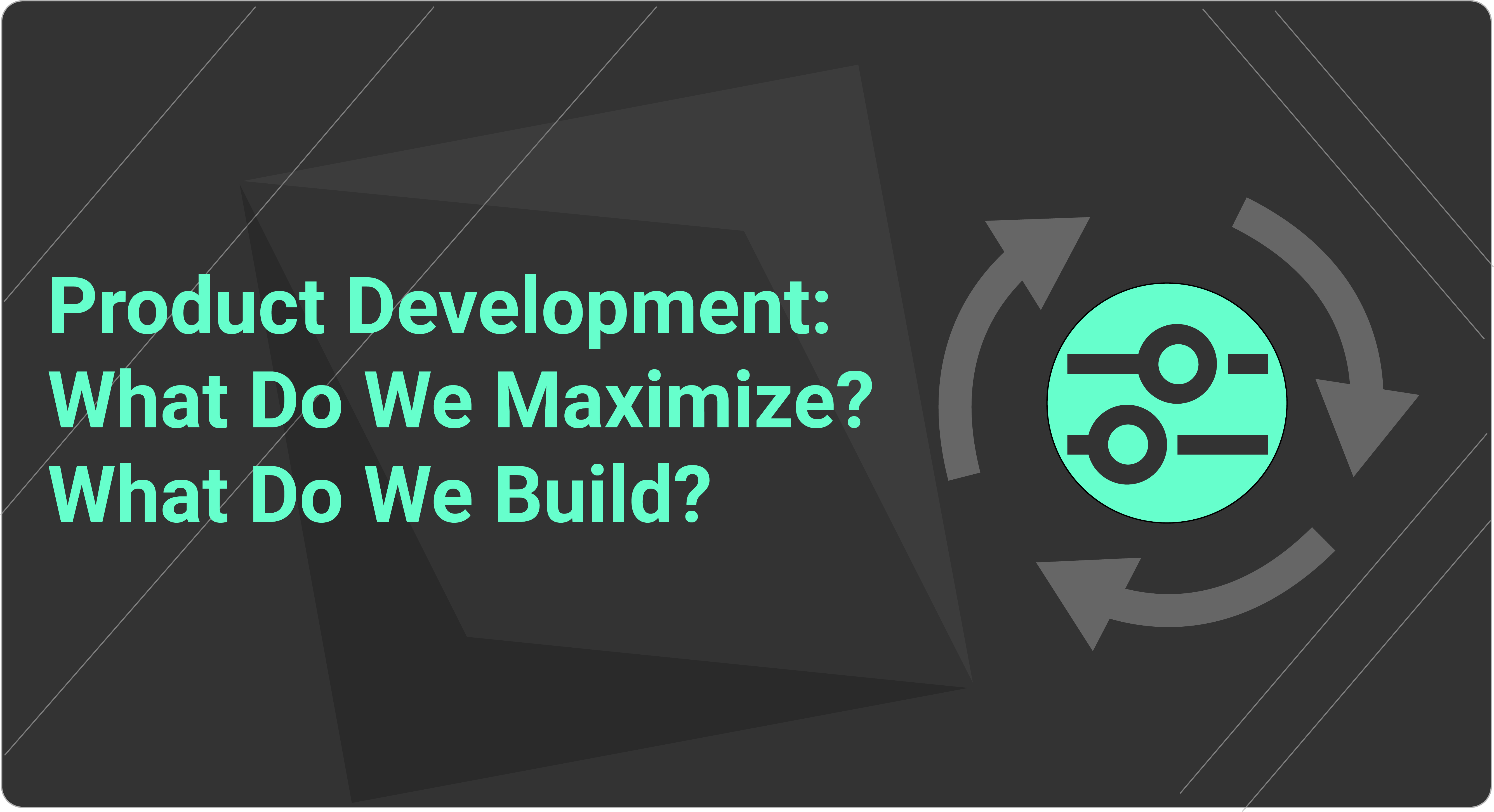

Cam Lynch
in this post:
Hey everyone, thanks for checking out the second blog post — feel free to check out what this blog aims to do here. This post is about applying min-maxing to critical concepts in product development. The reality is in this hyper-competitive tech world, building a product without defining the steps or looking into what you are trying to ship is far too risky. Product leaders build an intimate knowledge of their products through quantitative and qualitative data approaches. They do this to create new product features, push their work benchmarks, and offer a better experience to that product’s users. This page points product professionals to some ideas on the core principles of the development process.
TL;DR:
- Product Development is about maximizing acquisition, activation, and retention.
- User Acquisition: Get more users
- Revenue: Increase Revenue Per User
- User Engagement: Increase User Engagement and Retention
- Map out your app’s frequency of use, user intent, whether they have habits or use cases
- Frequency of use dictates your app, not the monetization strategy, build around your use cases and product goals, not the monetization model.
- Understand if you are creating a low intent habit or a high intent service
- I.e., is your product a candy or a painkiller
- There are a lot of ways to start your product development. First, make sure to familiarize all the frameworks when working on a new project.
- Strategy Analysis: if this is not done well, your product will fail or never be able to scale
- Requirements & Design: these can drastically impact the user’s engagement, regardless if you identified the market and core loop — if you make the product poorly — it will perform poorly
- Solution Evaluation: requires extensive knowledge and lots of failures — if it does fail, how do you improve it? Do you abandon the product?
What is Product Development?
Product development is the process of shipping a new product or maximizing an existing one. We focus on how we source user intent and wants from a user and how We apply those stories to our new and old products to create core loops that allow for product scalability and pass our product benchmarks. This page applies to all products but, some cases from mobile games will be used to make examples.
The first funnel metric that all modern tech products try to maximize is their ability to acquire users that will be high-value users (i.e., they are likely to purchase items, play lots of games, or interact with the app every day. Once the app acquires the user, the primary goal metric is retention; this is how all products benchmark. Retention is how long a user that installs your app will remain using the app—denoted in days, weeks, months, or years depending on the product. The longer a user retains, the more user value that user will generate. If a user keeps longer, they will have more engagement completing more core loops and being exposed to the monetization method that your product implemented. Now that I introduced you briefly to the core three areas of product health let’s cover the core loop and what impacts that system.
Understanding The Core Loop
The core loop for a product leader in the core of the product… Get it? Seriously, though, the core loop is referred to as the main action of your game or product and defines it. So a core loop can start a level, shoot the bad guys, reach the end and do it again. The core loop is directly connected to the frequency of use, user intent, and monetization method for our products and the products’ performance as a result. So let’s unpack frequency of use, user intent, and monetization method.
Frequency of use
Below you can see a timeline between daily use, monthly, and yearly use. This timeline aims to show that as the frequency in use becomes less, the more intent the user has to engage with that product or service — in other words, the user has a specific use case to solve. On the other hand, when the frequency of use is high (daily, weekly), the habit formation increases drastically, making it a low intent but high habit action. 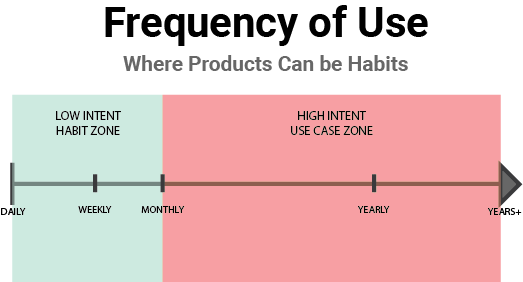
Product Frequency of Compared to Intent, Habit, and Use Case Zones
This use timeline frequency aims to guide when a product leader creates a new product from scratch or auditing their current product. Where your product lies in a low intent habit zone or a high intent use case zone is how you decide your product features and monetization methods.
What is User Intent?
A great way to think of a product, especially in gaming, is user intent. User intent means that it is motivating a user to complete the core loop’s actions. Quantic Foundry is a game research company that specializes in researching gamer motivation. Motivation is very similar to intent; they both focus on the user’s aims; let’s dive into that.
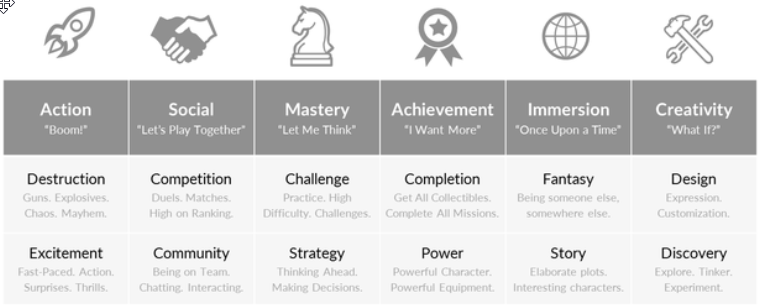
Quantic Foundry Gamer Motivation Table
Let’s first focus on the motivations of a mobile shooter such as Call of Duty by Activision. Call of Duty might focus on destruction, excitement, competition, challenge, and power per their model. In contrast, Candy Crush by King might bring challenge, strategy, completion, and discovery. What motivations allow us to do is segment similar areas and create user stories and personas of who consumes our content. Going back to the Call of Duty example, destructions mean the user feels powerful and powerful compared to their peers. So we can use research to map these to certain segments, i.e., Males and younger demographics.
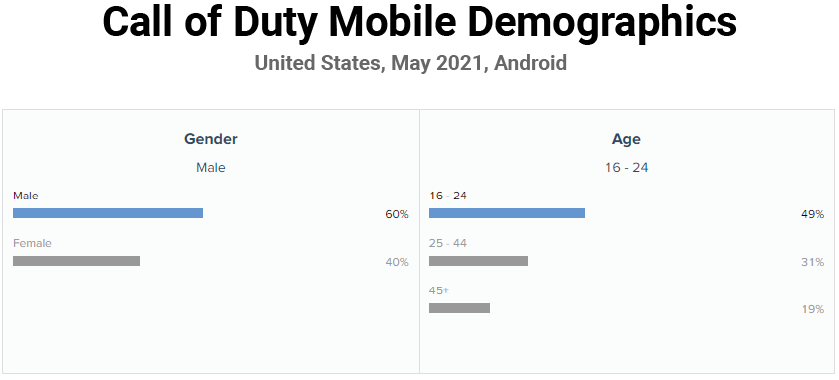
Data was taken from App Annie 6/17/2021
The goal of a product leader is to generate revenue from addressing a current user’s intent. Through identifying a user’s intent, we can make decisions or change VIA product features to capture a new market’s user intent or better capture our current market. We can capture this system and represent it in the core loop through the player value map. Let’s try to make an example player value map for Call of Duty Mobile.
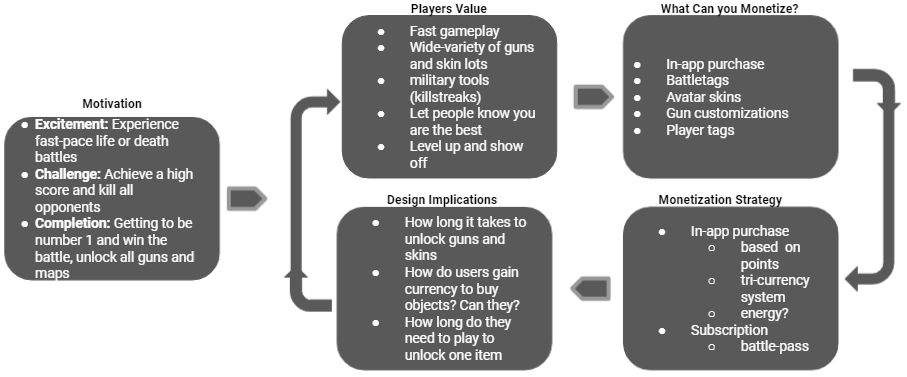
A player value map showing their motivations and possible core loop.
Okay, What is After Frequency of Use and User Intent?
What is the next step? First, we have to define the product’s orientation if it is a habit or use case product orientation. Then we need to illustrate a unique selling point, i.e., the particular feature or use case that separates it from other products in the market. However, before we do that, I want to explain the differences between a habit-oriented product and a use case-oriented product.
Please note, use cases and or user stories are present in all products and are fundamental development steps; for a habit app, we can have a use case of photo editing, for example — please remember the distinction of orientation meaning which is app positioning. So, if we look at habit and use case orientations, a habit can be defined as:
“something that you do often and regularly, sometimes without knowing that you are doing it.”
Now, if we look at a definition of use case:
“an instance of a particular situation; an example of something occurring.”
So when applying this to the product, these are two entirely separate scenarios that we are unable to group. Habit is based on low intent actions a user can fall into, and a great example is Tik Tok; it is highly addictive you can think of this as candy — check this case study on Tik Tok. Furthermore, there is no expectation beyond addictivity, meaning that a user can enter the product without any barriers — little onboarding friction to cause issues in habit formation.
On the other hand, a use case is a particular and exciting scenario where your product services have to break out from the other offerings, I view a use case as needing to have a USP (unique selling point), and it is a painkiller for demanding tasks. You have to have a robust product offering, while you just need to conquer the virality and popularity hill in the case of a habit. Of course, Tik Tok innovated, which caused the popularity, but it is a low intent habit that caused that snowball, not its product offerings. Use case-based products are harder to scale but often are not based on the ad model, freemium, but rather that higher intent subscription and transaction models.
What About Monetization?
Monetization is a requirement, but it is not the product. There are many models of monetization; check below. However, most common in hypercasual is ad monetization. Hypercasual deals with low intent users who churn or stop playing the product very quickly. According to SuperSonic, a subsidiary of Ironsource, a popular ad monetization platform, averaged D1 Retention in Hyper casual is 42%, so 42% of users return the day after installation or D0. When we move to higher intent products, we see that often the monetization model changes. Products with a subscription are boasting super long life cycles of users. Netflix for example boasts a 72% 6-month retention. Habit and intent drastically change the max potential; for a product to change its monetization potential, the first step is to address its frequency of use and intent. That way, they can prioritize the product changes they can make to maximize their goal market or grow outside their market.
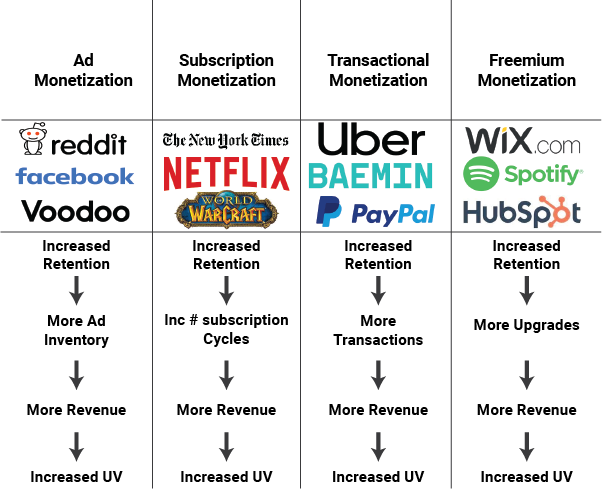
Examples of companies and the methods they use
Things to note are that there a multitude of different products using the same monetization models, they just tweak their core loop and sell different products to their users. Important to recognize that a use-case-oriented product and a habit-oriented product can share the same monetization model and that those models are not exclusive to the product positioning, but more towards the frequency of use and user intent’s output which is user engagement.
Product Development Process:
So now that you had a four-minute crash course into what a product is, you as a product leader need to be able to translate these requirements into a product roadmap and spend some engineering resources to ship it to users — sounds easy, right?
Serve to connect the user’s needs to a solution or feature. Since a product leader’s primary responsibility is understanding the users and connecting their requirements to a development team, it is standard to have a process to do this. Once you develop an understanding of your market VIA, identifying the frequency of use, user intent, and where your product sits in terms of habit and or use case. You can take a picture of the whole development process.
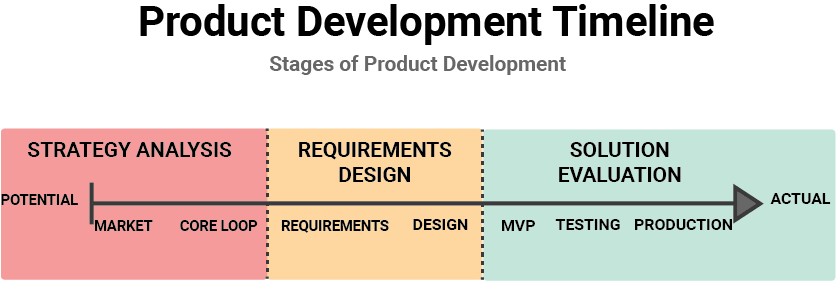
This is the Product design process, and it starts with understanding the users and collecting requirements for testing and the final release.
The Product Development process started with a strategic analysis to identify the market and create our core loop. Once you do that, you need to translate these into requirements, user stories, or use cases. With that, you make the design and start to ship the MVP to provide a proof of concept. The testing stage is often soft launching for mobile apps in low-value geo to prove marketability and optimize the core loop and product assets. At the beginning of the project, there is the only potential. It can often be life-or-death for your product, so take care in stressing the potential uplift of the three primary metrics of a product: user acquisition, user engagement, retention, and finally, revenue.
I will be doing deep dives into all of these subjects. But for now, it is essential to understand that products are developed by looking at the frequency of use, user intent, and then the monetization model is put on top of that. So every day, you will be balancing the core loop that retains users based on a user’s intent and those monetization methods that will reduce a user’s willingness to continue to use your product.
Product Development is a tricky section to cover in one blog post, so that I will dig into each section I mentioned in greater detail in future blog posts. Also, make sure to stick around for the following article focusing a little more on tech and defining technical architecture.I am happy to converse with all — reach out at cam@min-max.tech
References:
Bloomberg Second Measure. “Disney+ Takes Customer Retention Crown from Netflix,” https://secondmeasure.com/datapoints/disney-takes-customer-retention-crown-from-netflix/.
Eng, Dave. “Core Loops.” Medium, December 3, 2019. https://medium.com/@davengdesign/core-loops-c98b1197e93d.
Supersonic. “How to Improve the LTV of Your Hyper-Casual Game,” December 17, 2020. https://supersonic.com/blog/how-to-improve-the-ltv-of-your-hyper-casual-game/.
Shek. “Strategizing for Growth: Part 2 – Building Engaging Products (Core Loop).” Medium, June 15, 2018. https://medium.com/@abishek/strategizing-for-growth-part-2-building-engaging-products-core-loop-380e0bdea3ad.
“The Psychology Behind TikTok’s Addictive Feed.” https://growth.design/case-studies/tiktok-feed-psychology/.
Optimizely. “Unique Selling Point.” https://www.optimizely.com/optimization-glossary/unique-selling-point/.